Effective Knowledge Management for Singapore Organizations
VerifiedAdded on 2021/06/16
|16
|3543
|21
Essay
AI Summary
This essay provides a comprehensive overview of knowledge management within the context of Singapore's business environment. It delves into the significance of knowledge management as a discipline and its role in fostering an innovative, agile, and productive workplace. The essay highlights the importance of human resource management (HRM) practices in managing knowledge workers, including recruitment and selection, training and development, and performance management and rewards. It further explores the concepts of organizational learning, the learning organization, and how redesigning HR management systems can enhance innovation and competitive advantage. The essay also discusses the knowledge management model of Nonaka and Takeuchi, emphasizing the conversion of tacit to explicit knowledge. It concludes with recommendations for effective knowledge management and HR strategies within Singaporean organizations.
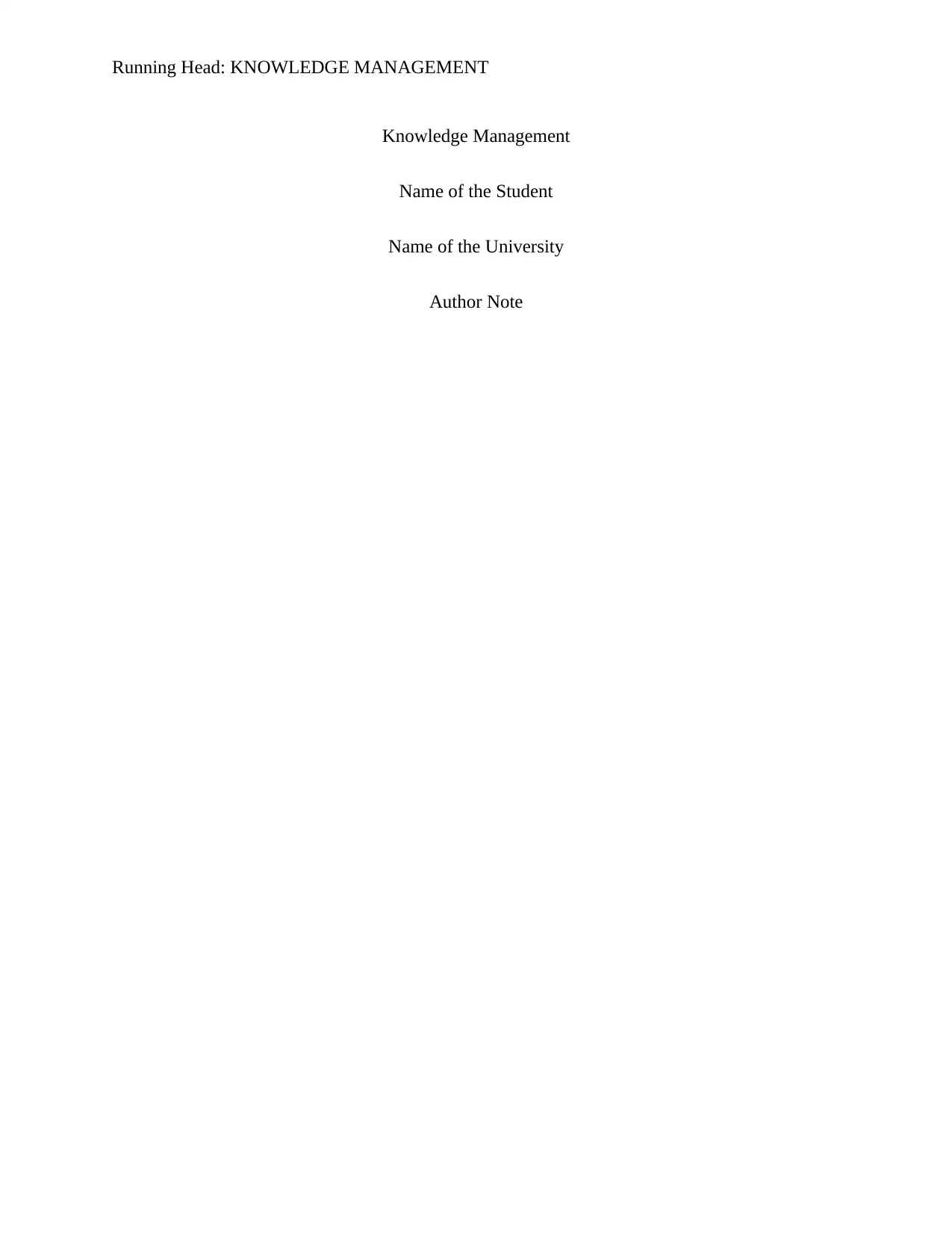
Running Head: KNOWLEDGE MANAGEMENT
Knowledge Management
Name of the Student
Name of the University
Author Note
Knowledge Management
Name of the Student
Name of the University
Author Note
Paraphrase This Document
Need a fresh take? Get an instant paraphrase of this document with our AI Paraphraser
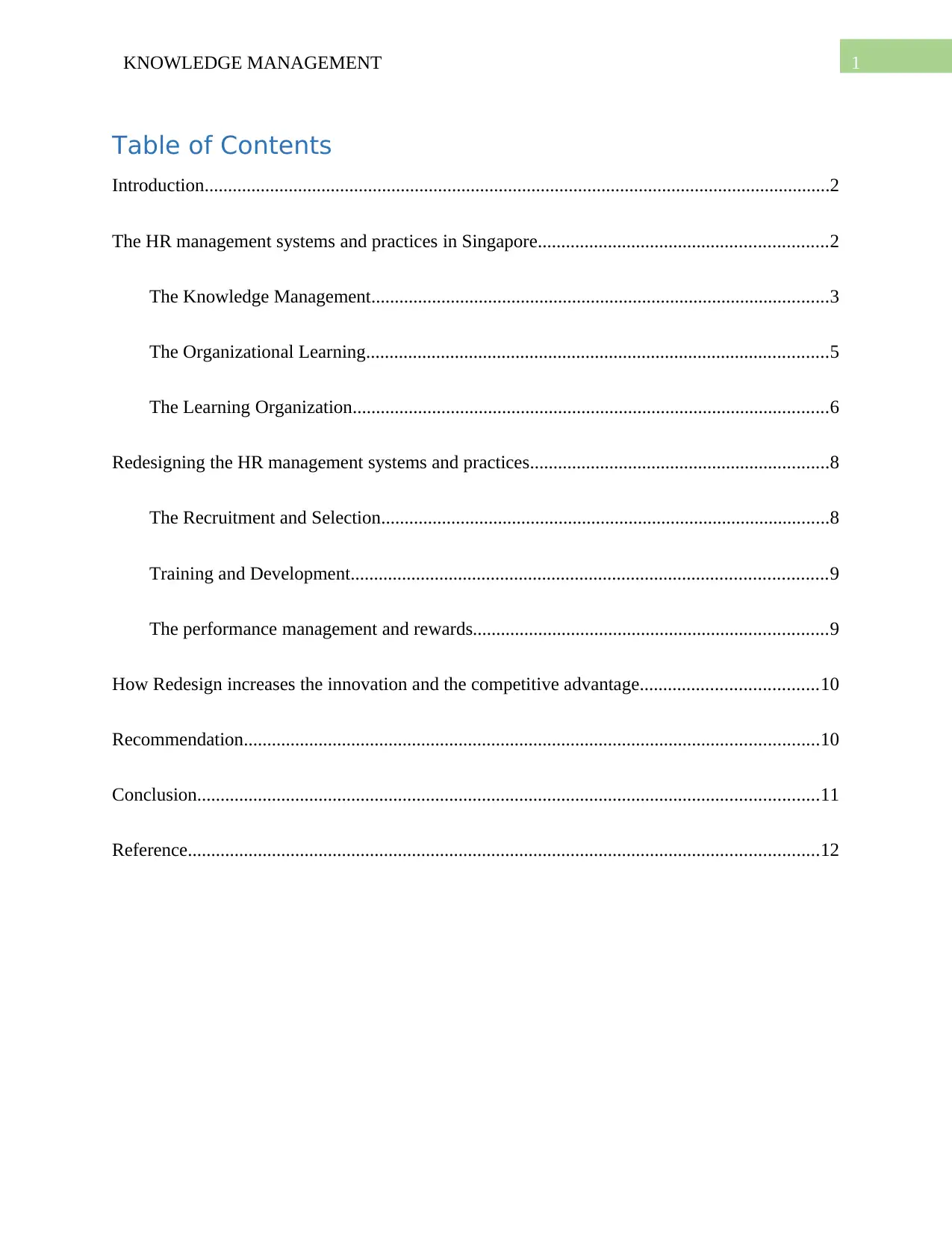
1KNOWLEDGE MANAGEMENT
Table of Contents
Introduction......................................................................................................................................2
The HR management systems and practices in Singapore..............................................................2
The Knowledge Management..................................................................................................3
The Organizational Learning...................................................................................................5
The Learning Organization......................................................................................................6
Redesigning the HR management systems and practices................................................................8
The Recruitment and Selection................................................................................................8
Training and Development......................................................................................................9
The performance management and rewards............................................................................9
How Redesign increases the innovation and the competitive advantage......................................10
Recommendation...........................................................................................................................10
Conclusion.....................................................................................................................................11
Reference.......................................................................................................................................12
Table of Contents
Introduction......................................................................................................................................2
The HR management systems and practices in Singapore..............................................................2
The Knowledge Management..................................................................................................3
The Organizational Learning...................................................................................................5
The Learning Organization......................................................................................................6
Redesigning the HR management systems and practices................................................................8
The Recruitment and Selection................................................................................................8
Training and Development......................................................................................................9
The performance management and rewards............................................................................9
How Redesign increases the innovation and the competitive advantage......................................10
Recommendation...........................................................................................................................10
Conclusion.....................................................................................................................................11
Reference.......................................................................................................................................12
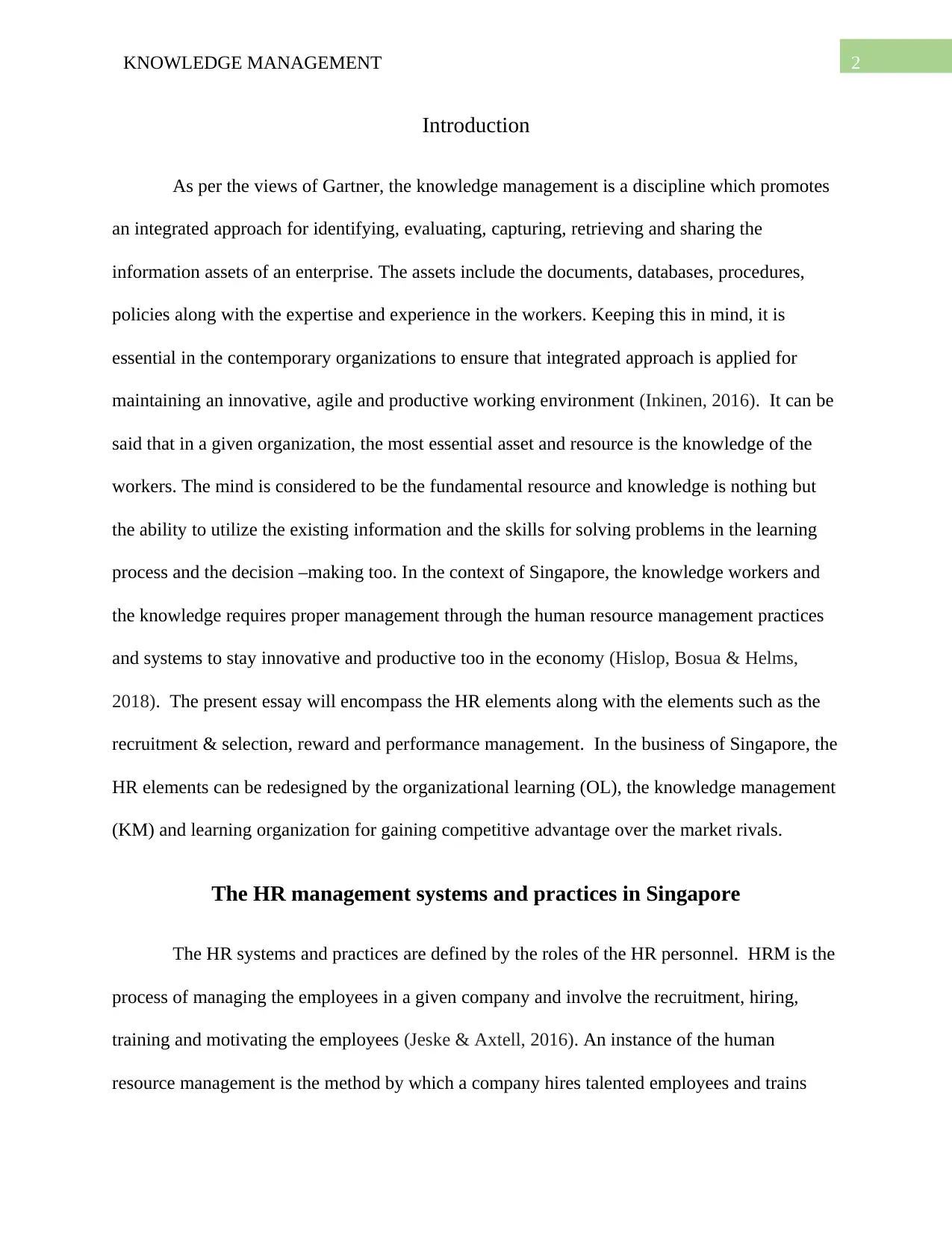
2KNOWLEDGE MANAGEMENT
Introduction
As per the views of Gartner, the knowledge management is a discipline which promotes
an integrated approach for identifying, evaluating, capturing, retrieving and sharing the
information assets of an enterprise. The assets include the documents, databases, procedures,
policies along with the expertise and experience in the workers. Keeping this in mind, it is
essential in the contemporary organizations to ensure that integrated approach is applied for
maintaining an innovative, agile and productive working environment (Inkinen, 2016). It can be
said that in a given organization, the most essential asset and resource is the knowledge of the
workers. The mind is considered to be the fundamental resource and knowledge is nothing but
the ability to utilize the existing information and the skills for solving problems in the learning
process and the decision –making too. In the context of Singapore, the knowledge workers and
the knowledge requires proper management through the human resource management practices
and systems to stay innovative and productive too in the economy (Hislop, Bosua & Helms,
2018). The present essay will encompass the HR elements along with the elements such as the
recruitment & selection, reward and performance management. In the business of Singapore, the
HR elements can be redesigned by the organizational learning (OL), the knowledge management
(KM) and learning organization for gaining competitive advantage over the market rivals.
The HR management systems and practices in Singapore
The HR systems and practices are defined by the roles of the HR personnel. HRM is the
process of managing the employees in a given company and involve the recruitment, hiring,
training and motivating the employees (Jeske & Axtell, 2016). An instance of the human
resource management is the method by which a company hires talented employees and trains
Introduction
As per the views of Gartner, the knowledge management is a discipline which promotes
an integrated approach for identifying, evaluating, capturing, retrieving and sharing the
information assets of an enterprise. The assets include the documents, databases, procedures,
policies along with the expertise and experience in the workers. Keeping this in mind, it is
essential in the contemporary organizations to ensure that integrated approach is applied for
maintaining an innovative, agile and productive working environment (Inkinen, 2016). It can be
said that in a given organization, the most essential asset and resource is the knowledge of the
workers. The mind is considered to be the fundamental resource and knowledge is nothing but
the ability to utilize the existing information and the skills for solving problems in the learning
process and the decision –making too. In the context of Singapore, the knowledge workers and
the knowledge requires proper management through the human resource management practices
and systems to stay innovative and productive too in the economy (Hislop, Bosua & Helms,
2018). The present essay will encompass the HR elements along with the elements such as the
recruitment & selection, reward and performance management. In the business of Singapore, the
HR elements can be redesigned by the organizational learning (OL), the knowledge management
(KM) and learning organization for gaining competitive advantage over the market rivals.
The HR management systems and practices in Singapore
The HR systems and practices are defined by the roles of the HR personnel. HRM is the
process of managing the employees in a given company and involve the recruitment, hiring,
training and motivating the employees (Jeske & Axtell, 2016). An instance of the human
resource management is the method by which a company hires talented employees and trains
⊘ This is a preview!⊘
Do you want full access?
Subscribe today to unlock all pages.

Trusted by 1+ million students worldwide
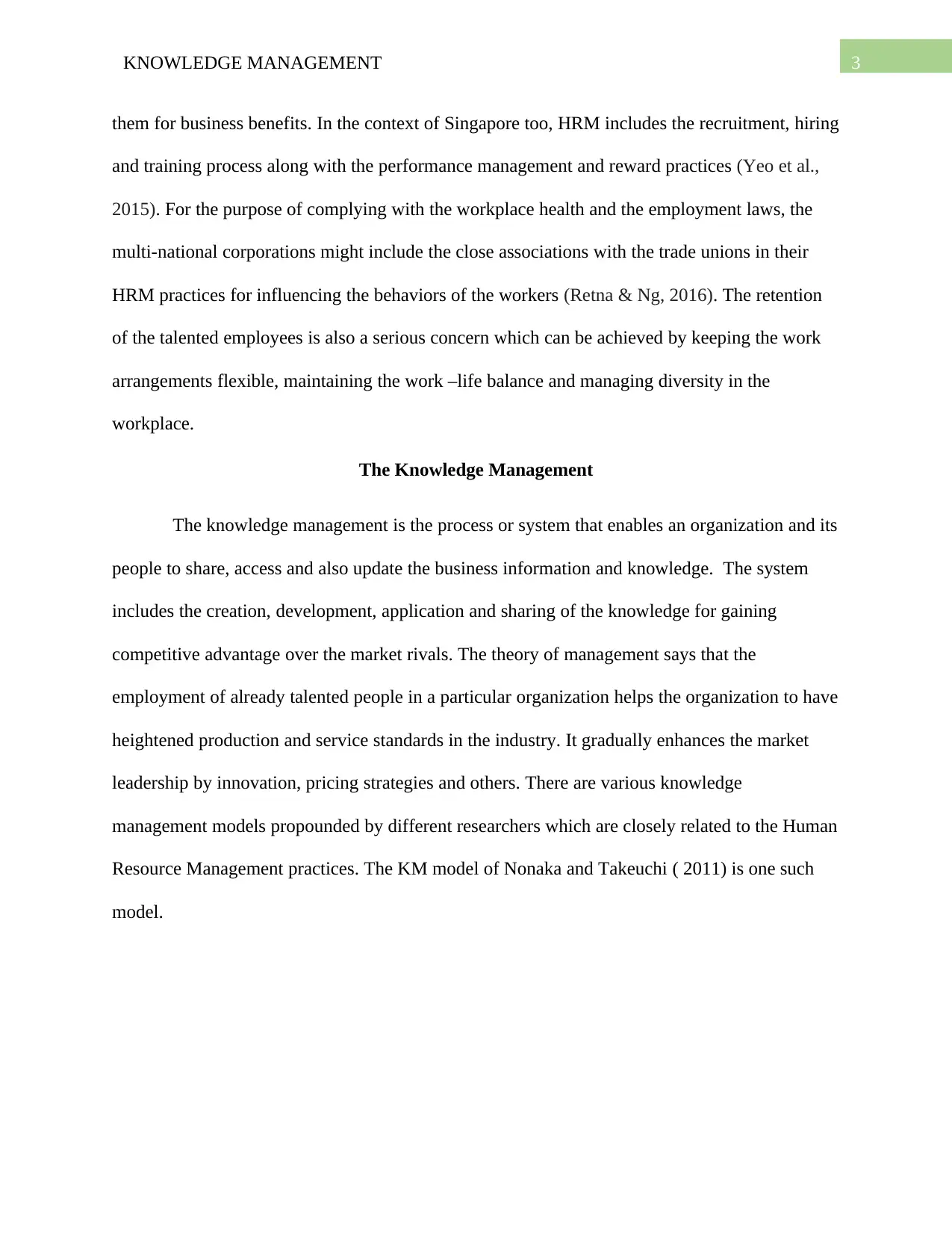
3KNOWLEDGE MANAGEMENT
them for business benefits. In the context of Singapore too, HRM includes the recruitment, hiring
and training process along with the performance management and reward practices (Yeo et al.,
2015). For the purpose of complying with the workplace health and the employment laws, the
multi-national corporations might include the close associations with the trade unions in their
HRM practices for influencing the behaviors of the workers (Retna & Ng, 2016). The retention
of the talented employees is also a serious concern which can be achieved by keeping the work
arrangements flexible, maintaining the work –life balance and managing diversity in the
workplace.
The Knowledge Management
The knowledge management is the process or system that enables an organization and its
people to share, access and also update the business information and knowledge. The system
includes the creation, development, application and sharing of the knowledge for gaining
competitive advantage over the market rivals. The theory of management says that the
employment of already talented people in a particular organization helps the organization to have
heightened production and service standards in the industry. It gradually enhances the market
leadership by innovation, pricing strategies and others. There are various knowledge
management models propounded by different researchers which are closely related to the Human
Resource Management practices. The KM model of Nonaka and Takeuchi ( 2011) is one such
model.
them for business benefits. In the context of Singapore too, HRM includes the recruitment, hiring
and training process along with the performance management and reward practices (Yeo et al.,
2015). For the purpose of complying with the workplace health and the employment laws, the
multi-national corporations might include the close associations with the trade unions in their
HRM practices for influencing the behaviors of the workers (Retna & Ng, 2016). The retention
of the talented employees is also a serious concern which can be achieved by keeping the work
arrangements flexible, maintaining the work –life balance and managing diversity in the
workplace.
The Knowledge Management
The knowledge management is the process or system that enables an organization and its
people to share, access and also update the business information and knowledge. The system
includes the creation, development, application and sharing of the knowledge for gaining
competitive advantage over the market rivals. The theory of management says that the
employment of already talented people in a particular organization helps the organization to have
heightened production and service standards in the industry. It gradually enhances the market
leadership by innovation, pricing strategies and others. There are various knowledge
management models propounded by different researchers which are closely related to the Human
Resource Management practices. The KM model of Nonaka and Takeuchi ( 2011) is one such
model.
Paraphrase This Document
Need a fresh take? Get an instant paraphrase of this document with our AI Paraphraser
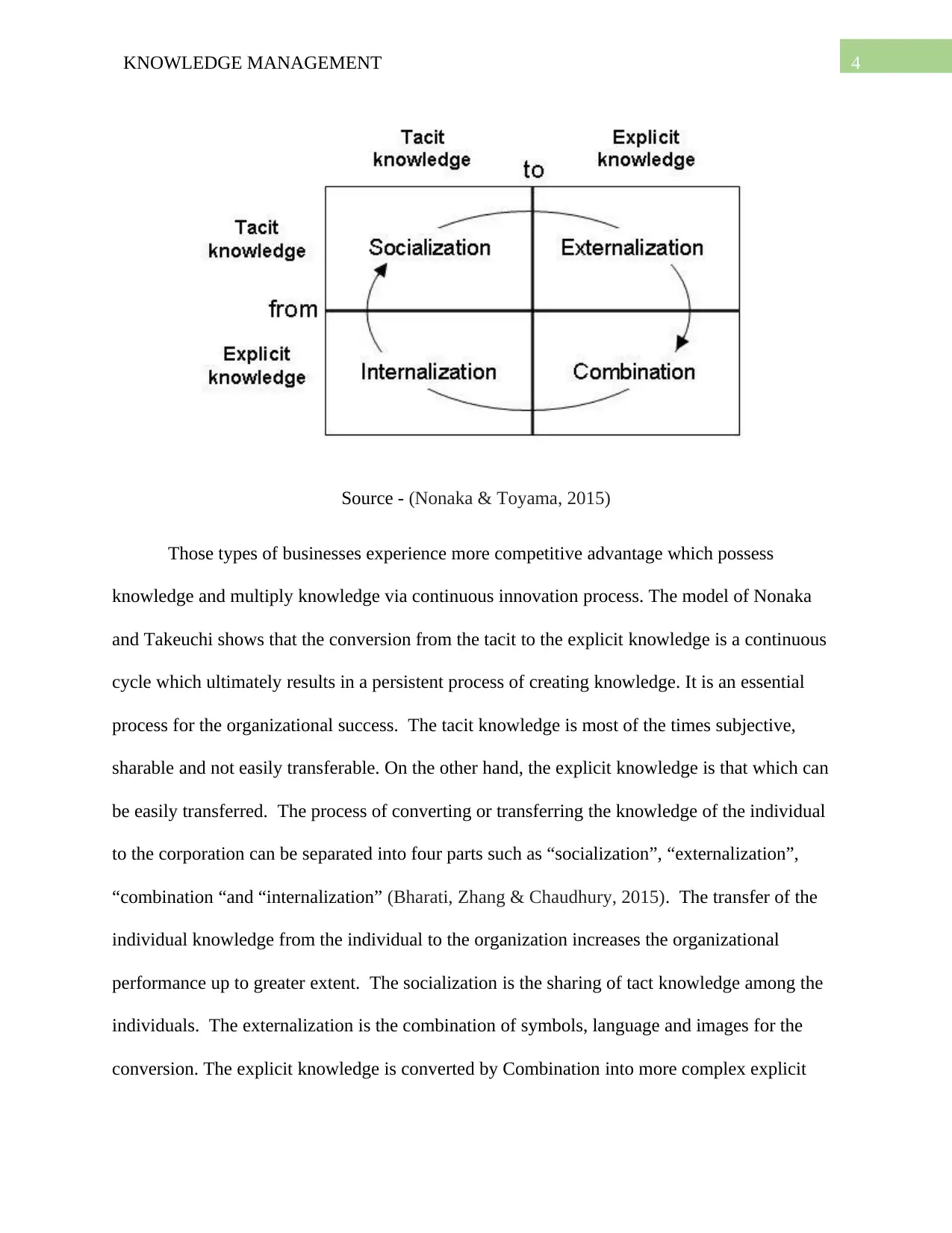
4KNOWLEDGE MANAGEMENT
Source - (Nonaka & Toyama, 2015)
Those types of businesses experience more competitive advantage which possess
knowledge and multiply knowledge via continuous innovation process. The model of Nonaka
and Takeuchi shows that the conversion from the tacit to the explicit knowledge is a continuous
cycle which ultimately results in a persistent process of creating knowledge. It is an essential
process for the organizational success. The tacit knowledge is most of the times subjective,
sharable and not easily transferable. On the other hand, the explicit knowledge is that which can
be easily transferred. The process of converting or transferring the knowledge of the individual
to the corporation can be separated into four parts such as “socialization”, “externalization”,
“combination “and “internalization” (Bharati, Zhang & Chaudhury, 2015). The transfer of the
individual knowledge from the individual to the organization increases the organizational
performance up to greater extent. The socialization is the sharing of tact knowledge among the
individuals. The externalization is the combination of symbols, language and images for the
conversion. The explicit knowledge is converted by Combination into more complex explicit
Source - (Nonaka & Toyama, 2015)
Those types of businesses experience more competitive advantage which possess
knowledge and multiply knowledge via continuous innovation process. The model of Nonaka
and Takeuchi shows that the conversion from the tacit to the explicit knowledge is a continuous
cycle which ultimately results in a persistent process of creating knowledge. It is an essential
process for the organizational success. The tacit knowledge is most of the times subjective,
sharable and not easily transferable. On the other hand, the explicit knowledge is that which can
be easily transferred. The process of converting or transferring the knowledge of the individual
to the corporation can be separated into four parts such as “socialization”, “externalization”,
“combination “and “internalization” (Bharati, Zhang & Chaudhury, 2015). The transfer of the
individual knowledge from the individual to the organization increases the organizational
performance up to greater extent. The socialization is the sharing of tact knowledge among the
individuals. The externalization is the combination of symbols, language and images for the
conversion. The explicit knowledge is converted by Combination into more complex explicit
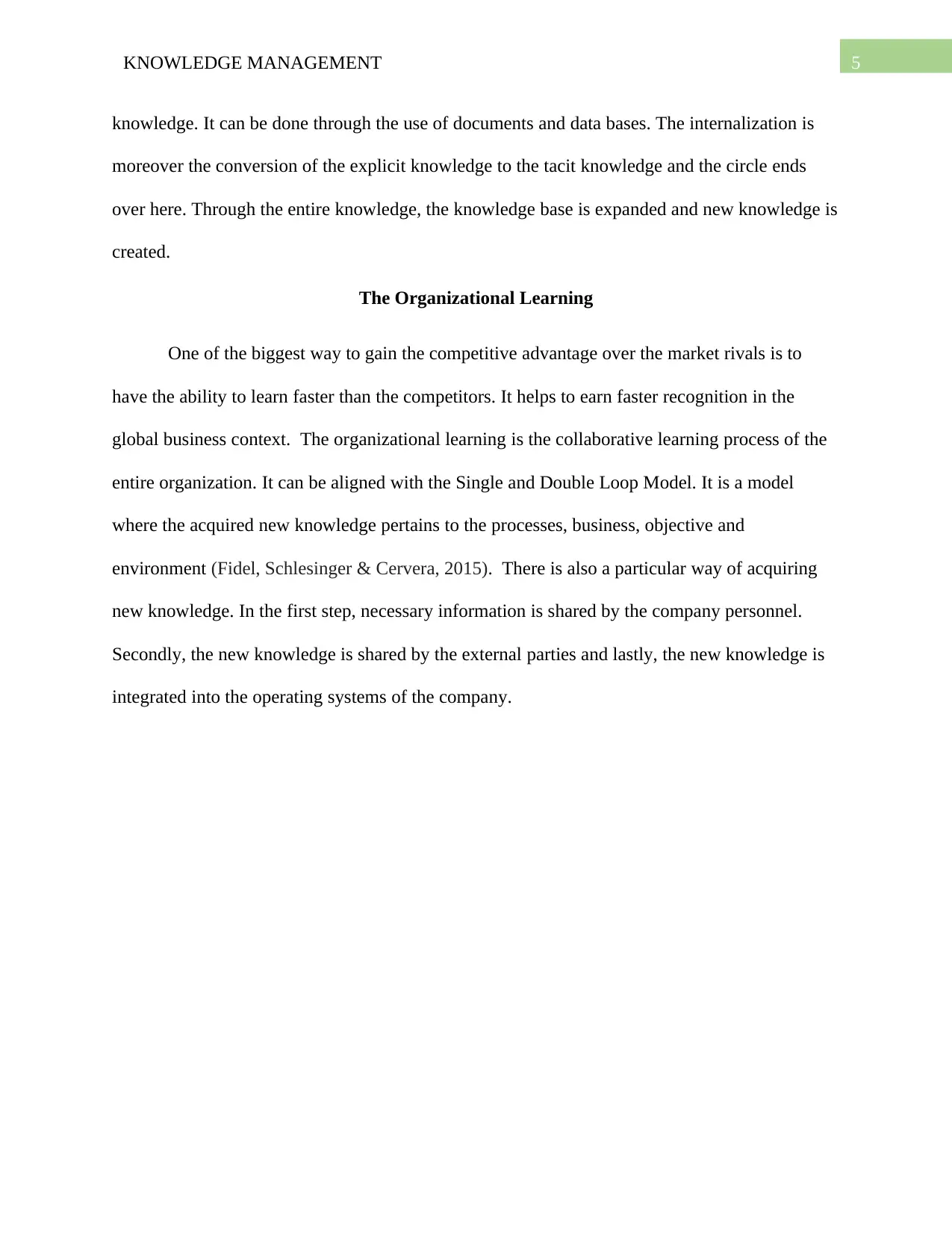
5KNOWLEDGE MANAGEMENT
knowledge. It can be done through the use of documents and data bases. The internalization is
moreover the conversion of the explicit knowledge to the tacit knowledge and the circle ends
over here. Through the entire knowledge, the knowledge base is expanded and new knowledge is
created.
The Organizational Learning
One of the biggest way to gain the competitive advantage over the market rivals is to
have the ability to learn faster than the competitors. It helps to earn faster recognition in the
global business context. The organizational learning is the collaborative learning process of the
entire organization. It can be aligned with the Single and Double Loop Model. It is a model
where the acquired new knowledge pertains to the processes, business, objective and
environment (Fidel, Schlesinger & Cervera, 2015). There is also a particular way of acquiring
new knowledge. In the first step, necessary information is shared by the company personnel.
Secondly, the new knowledge is shared by the external parties and lastly, the new knowledge is
integrated into the operating systems of the company.
knowledge. It can be done through the use of documents and data bases. The internalization is
moreover the conversion of the explicit knowledge to the tacit knowledge and the circle ends
over here. Through the entire knowledge, the knowledge base is expanded and new knowledge is
created.
The Organizational Learning
One of the biggest way to gain the competitive advantage over the market rivals is to
have the ability to learn faster than the competitors. It helps to earn faster recognition in the
global business context. The organizational learning is the collaborative learning process of the
entire organization. It can be aligned with the Single and Double Loop Model. It is a model
where the acquired new knowledge pertains to the processes, business, objective and
environment (Fidel, Schlesinger & Cervera, 2015). There is also a particular way of acquiring
new knowledge. In the first step, necessary information is shared by the company personnel.
Secondly, the new knowledge is shared by the external parties and lastly, the new knowledge is
integrated into the operating systems of the company.
⊘ This is a preview!⊘
Do you want full access?
Subscribe today to unlock all pages.

Trusted by 1+ million students worldwide
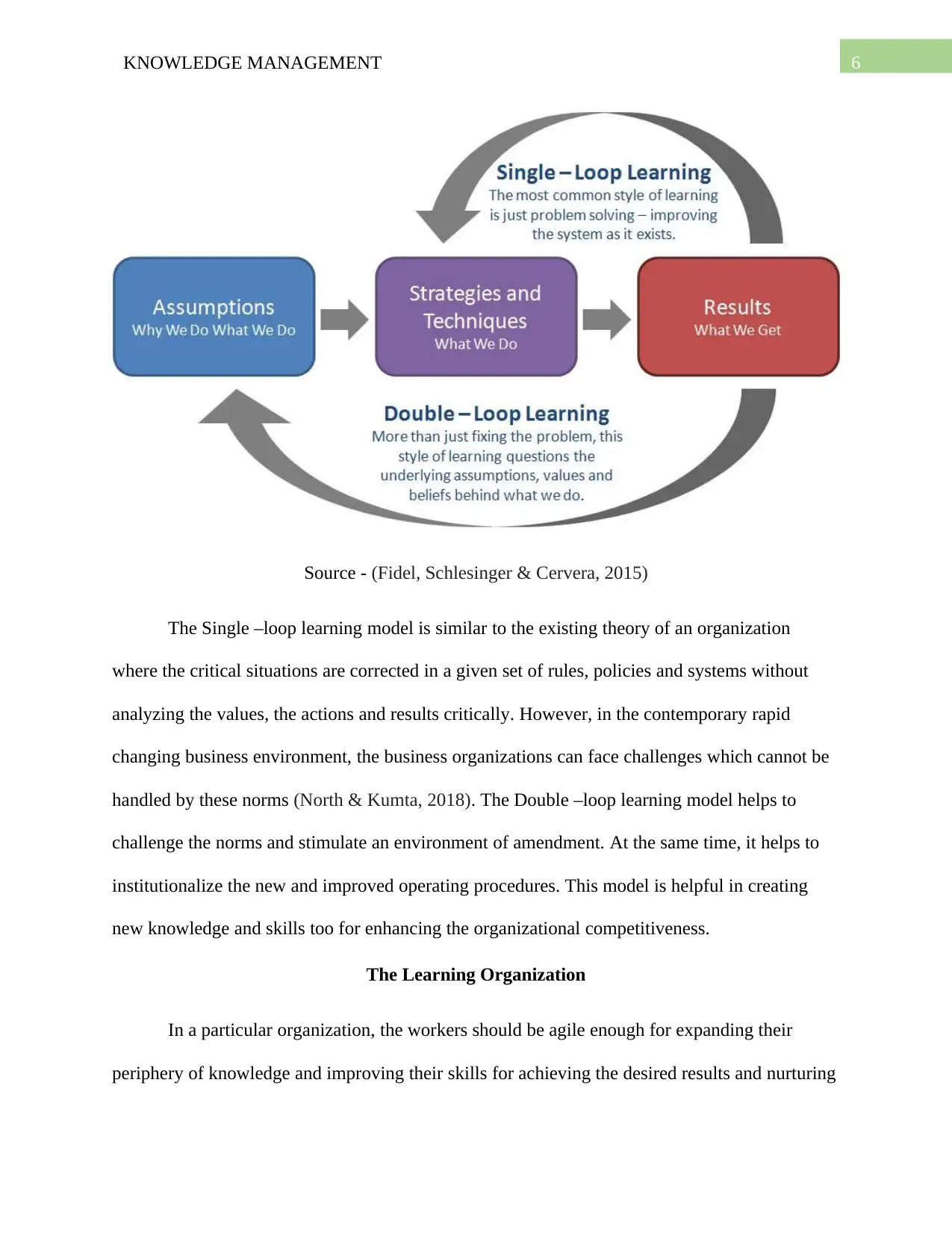
6KNOWLEDGE MANAGEMENT
Source - (Fidel, Schlesinger & Cervera, 2015)
The Single –loop learning model is similar to the existing theory of an organization
where the critical situations are corrected in a given set of rules, policies and systems without
analyzing the values, the actions and results critically. However, in the contemporary rapid
changing business environment, the business organizations can face challenges which cannot be
handled by these norms (North & Kumta, 2018). The Double –loop learning model helps to
challenge the norms and stimulate an environment of amendment. At the same time, it helps to
institutionalize the new and improved operating procedures. This model is helpful in creating
new knowledge and skills too for enhancing the organizational competitiveness.
The Learning Organization
In a particular organization, the workers should be agile enough for expanding their
periphery of knowledge and improving their skills for achieving the desired results and nurturing
Source - (Fidel, Schlesinger & Cervera, 2015)
The Single –loop learning model is similar to the existing theory of an organization
where the critical situations are corrected in a given set of rules, policies and systems without
analyzing the values, the actions and results critically. However, in the contemporary rapid
changing business environment, the business organizations can face challenges which cannot be
handled by these norms (North & Kumta, 2018). The Double –loop learning model helps to
challenge the norms and stimulate an environment of amendment. At the same time, it helps to
institutionalize the new and improved operating procedures. This model is helpful in creating
new knowledge and skills too for enhancing the organizational competitiveness.
The Learning Organization
In a particular organization, the workers should be agile enough for expanding their
periphery of knowledge and improving their skills for achieving the desired results and nurturing
Paraphrase This Document
Need a fresh take? Get an instant paraphrase of this document with our AI Paraphraser
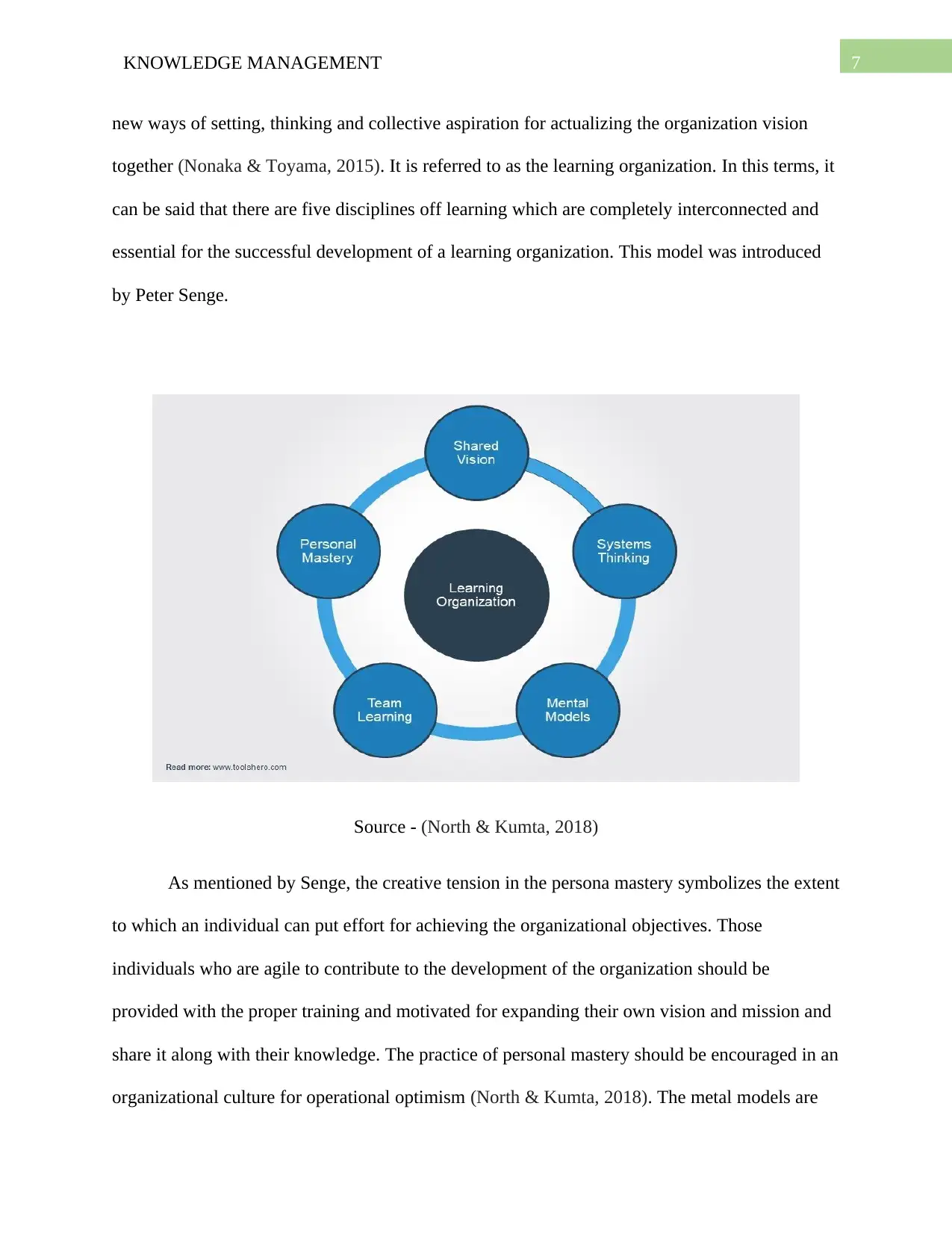
7KNOWLEDGE MANAGEMENT
new ways of setting, thinking and collective aspiration for actualizing the organization vision
together (Nonaka & Toyama, 2015). It is referred to as the learning organization. In this terms, it
can be said that there are five disciplines off learning which are completely interconnected and
essential for the successful development of a learning organization. This model was introduced
by Peter Senge.
Source - (North & Kumta, 2018)
As mentioned by Senge, the creative tension in the persona mastery symbolizes the extent
to which an individual can put effort for achieving the organizational objectives. Those
individuals who are agile to contribute to the development of the organization should be
provided with the proper training and motivated for expanding their own vision and mission and
share it along with their knowledge. The practice of personal mastery should be encouraged in an
organizational culture for operational optimism (North & Kumta, 2018). The metal models are
new ways of setting, thinking and collective aspiration for actualizing the organization vision
together (Nonaka & Toyama, 2015). It is referred to as the learning organization. In this terms, it
can be said that there are five disciplines off learning which are completely interconnected and
essential for the successful development of a learning organization. This model was introduced
by Peter Senge.
Source - (North & Kumta, 2018)
As mentioned by Senge, the creative tension in the persona mastery symbolizes the extent
to which an individual can put effort for achieving the organizational objectives. Those
individuals who are agile to contribute to the development of the organization should be
provided with the proper training and motivated for expanding their own vision and mission and
share it along with their knowledge. The practice of personal mastery should be encouraged in an
organizational culture for operational optimism (North & Kumta, 2018). The metal models are
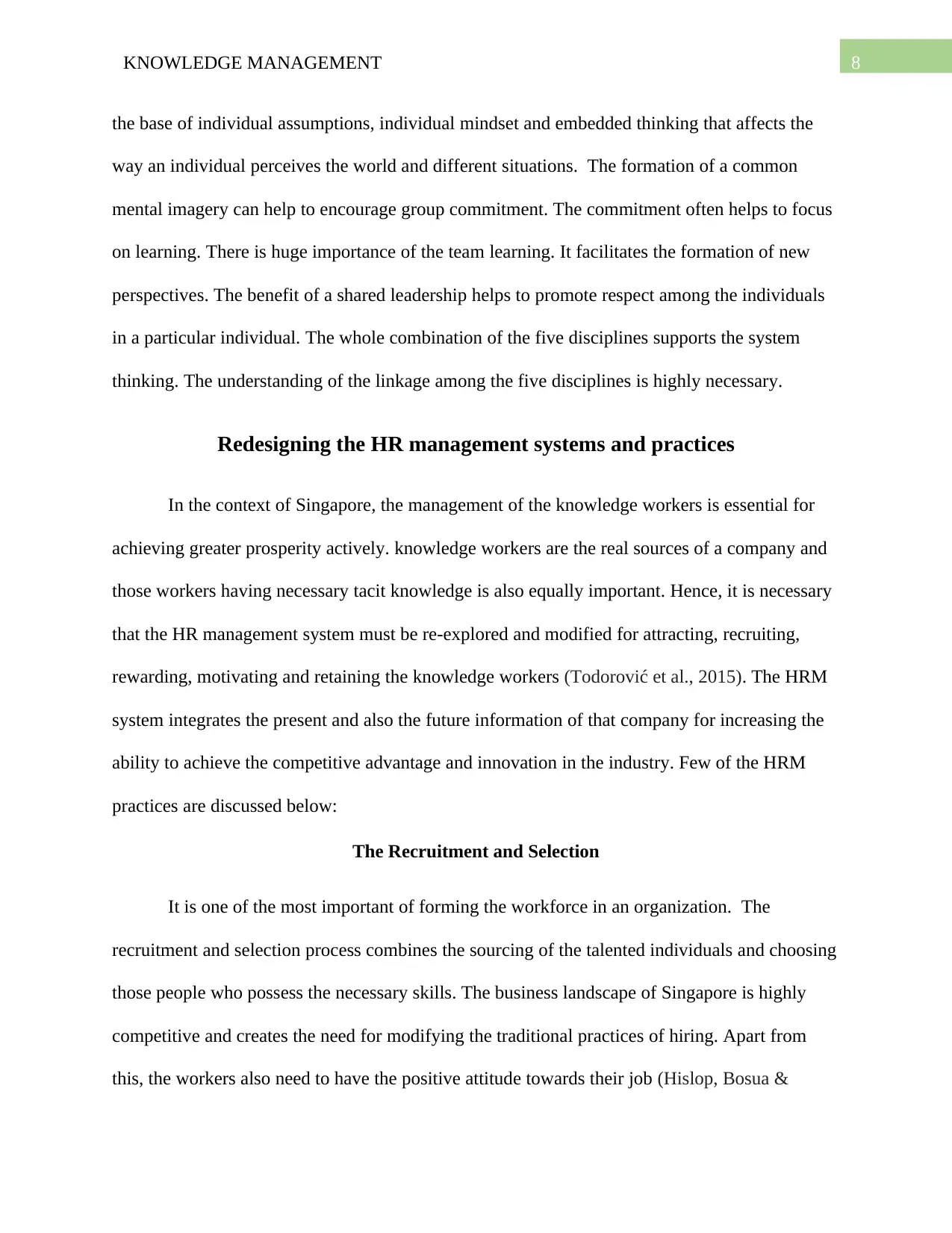
8KNOWLEDGE MANAGEMENT
the base of individual assumptions, individual mindset and embedded thinking that affects the
way an individual perceives the world and different situations. The formation of a common
mental imagery can help to encourage group commitment. The commitment often helps to focus
on learning. There is huge importance of the team learning. It facilitates the formation of new
perspectives. The benefit of a shared leadership helps to promote respect among the individuals
in a particular individual. The whole combination of the five disciplines supports the system
thinking. The understanding of the linkage among the five disciplines is highly necessary.
Redesigning the HR management systems and practices
In the context of Singapore, the management of the knowledge workers is essential for
achieving greater prosperity actively. knowledge workers are the real sources of a company and
those workers having necessary tacit knowledge is also equally important. Hence, it is necessary
that the HR management system must be re-explored and modified for attracting, recruiting,
rewarding, motivating and retaining the knowledge workers (Todorović et al., 2015). The HRM
system integrates the present and also the future information of that company for increasing the
ability to achieve the competitive advantage and innovation in the industry. Few of the HRM
practices are discussed below:
The Recruitment and Selection
It is one of the most important of forming the workforce in an organization. The
recruitment and selection process combines the sourcing of the talented individuals and choosing
those people who possess the necessary skills. The business landscape of Singapore is highly
competitive and creates the need for modifying the traditional practices of hiring. Apart from
this, the workers also need to have the positive attitude towards their job (Hislop, Bosua &
the base of individual assumptions, individual mindset and embedded thinking that affects the
way an individual perceives the world and different situations. The formation of a common
mental imagery can help to encourage group commitment. The commitment often helps to focus
on learning. There is huge importance of the team learning. It facilitates the formation of new
perspectives. The benefit of a shared leadership helps to promote respect among the individuals
in a particular individual. The whole combination of the five disciplines supports the system
thinking. The understanding of the linkage among the five disciplines is highly necessary.
Redesigning the HR management systems and practices
In the context of Singapore, the management of the knowledge workers is essential for
achieving greater prosperity actively. knowledge workers are the real sources of a company and
those workers having necessary tacit knowledge is also equally important. Hence, it is necessary
that the HR management system must be re-explored and modified for attracting, recruiting,
rewarding, motivating and retaining the knowledge workers (Todorović et al., 2015). The HRM
system integrates the present and also the future information of that company for increasing the
ability to achieve the competitive advantage and innovation in the industry. Few of the HRM
practices are discussed below:
The Recruitment and Selection
It is one of the most important of forming the workforce in an organization. The
recruitment and selection process combines the sourcing of the talented individuals and choosing
those people who possess the necessary skills. The business landscape of Singapore is highly
competitive and creates the need for modifying the traditional practices of hiring. Apart from
this, the workers also need to have the positive attitude towards their job (Hislop, Bosua &
⊘ This is a preview!⊘
Do you want full access?
Subscribe today to unlock all pages.

Trusted by 1+ million students worldwide
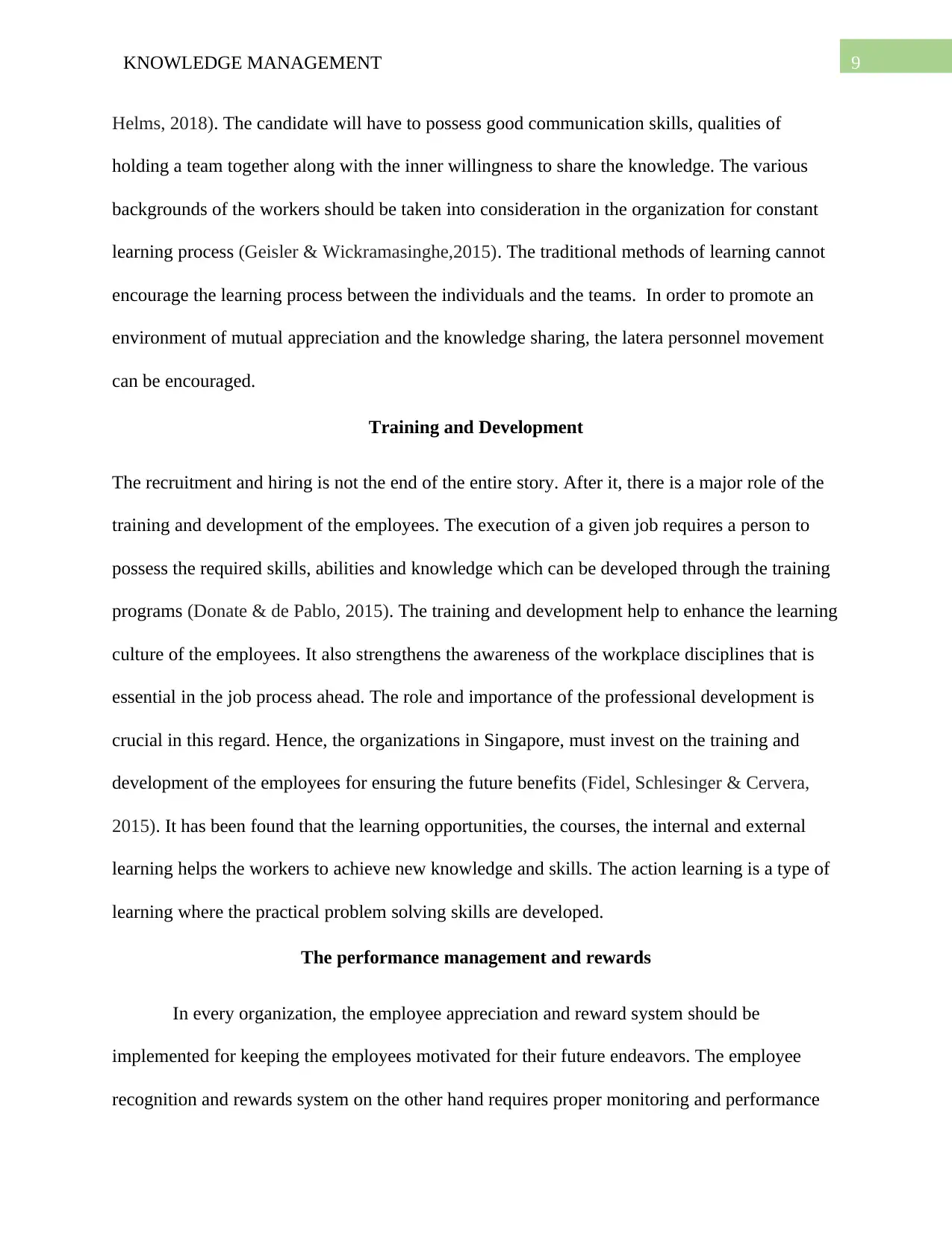
9KNOWLEDGE MANAGEMENT
Helms, 2018). The candidate will have to possess good communication skills, qualities of
holding a team together along with the inner willingness to share the knowledge. The various
backgrounds of the workers should be taken into consideration in the organization for constant
learning process (Geisler & Wickramasinghe,2015). The traditional methods of learning cannot
encourage the learning process between the individuals and the teams. In order to promote an
environment of mutual appreciation and the knowledge sharing, the latera personnel movement
can be encouraged.
Training and Development
The recruitment and hiring is not the end of the entire story. After it, there is a major role of the
training and development of the employees. The execution of a given job requires a person to
possess the required skills, abilities and knowledge which can be developed through the training
programs (Donate & de Pablo, 2015). The training and development help to enhance the learning
culture of the employees. It also strengthens the awareness of the workplace disciplines that is
essential in the job process ahead. The role and importance of the professional development is
crucial in this regard. Hence, the organizations in Singapore, must invest on the training and
development of the employees for ensuring the future benefits (Fidel, Schlesinger & Cervera,
2015). It has been found that the learning opportunities, the courses, the internal and external
learning helps the workers to achieve new knowledge and skills. The action learning is a type of
learning where the practical problem solving skills are developed.
The performance management and rewards
In every organization, the employee appreciation and reward system should be
implemented for keeping the employees motivated for their future endeavors. The employee
recognition and rewards system on the other hand requires proper monitoring and performance
Helms, 2018). The candidate will have to possess good communication skills, qualities of
holding a team together along with the inner willingness to share the knowledge. The various
backgrounds of the workers should be taken into consideration in the organization for constant
learning process (Geisler & Wickramasinghe,2015). The traditional methods of learning cannot
encourage the learning process between the individuals and the teams. In order to promote an
environment of mutual appreciation and the knowledge sharing, the latera personnel movement
can be encouraged.
Training and Development
The recruitment and hiring is not the end of the entire story. After it, there is a major role of the
training and development of the employees. The execution of a given job requires a person to
possess the required skills, abilities and knowledge which can be developed through the training
programs (Donate & de Pablo, 2015). The training and development help to enhance the learning
culture of the employees. It also strengthens the awareness of the workplace disciplines that is
essential in the job process ahead. The role and importance of the professional development is
crucial in this regard. Hence, the organizations in Singapore, must invest on the training and
development of the employees for ensuring the future benefits (Fidel, Schlesinger & Cervera,
2015). It has been found that the learning opportunities, the courses, the internal and external
learning helps the workers to achieve new knowledge and skills. The action learning is a type of
learning where the practical problem solving skills are developed.
The performance management and rewards
In every organization, the employee appreciation and reward system should be
implemented for keeping the employees motivated for their future endeavors. The employee
recognition and rewards system on the other hand requires proper monitoring and performance
Paraphrase This Document
Need a fresh take? Get an instant paraphrase of this document with our AI Paraphraser
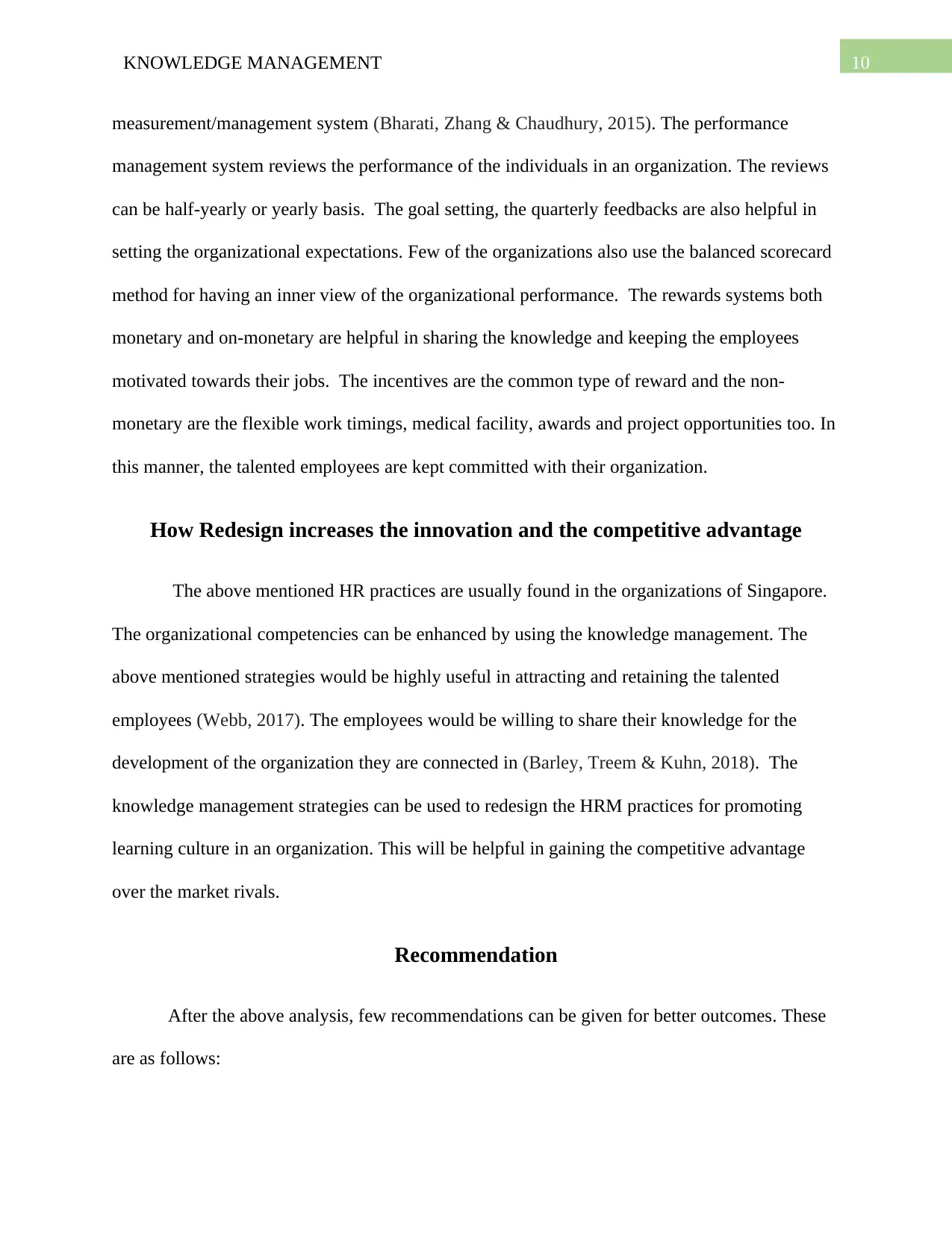
10KNOWLEDGE MANAGEMENT
measurement/management system (Bharati, Zhang & Chaudhury, 2015). The performance
management system reviews the performance of the individuals in an organization. The reviews
can be half-yearly or yearly basis. The goal setting, the quarterly feedbacks are also helpful in
setting the organizational expectations. Few of the organizations also use the balanced scorecard
method for having an inner view of the organizational performance. The rewards systems both
monetary and on-monetary are helpful in sharing the knowledge and keeping the employees
motivated towards their jobs. The incentives are the common type of reward and the non-
monetary are the flexible work timings, medical facility, awards and project opportunities too. In
this manner, the talented employees are kept committed with their organization.
How Redesign increases the innovation and the competitive advantage
The above mentioned HR practices are usually found in the organizations of Singapore.
The organizational competencies can be enhanced by using the knowledge management. The
above mentioned strategies would be highly useful in attracting and retaining the talented
employees (Webb, 2017). The employees would be willing to share their knowledge for the
development of the organization they are connected in (Barley, Treem & Kuhn, 2018). The
knowledge management strategies can be used to redesign the HRM practices for promoting
learning culture in an organization. This will be helpful in gaining the competitive advantage
over the market rivals.
Recommendation
After the above analysis, few recommendations can be given for better outcomes. These
are as follows:
measurement/management system (Bharati, Zhang & Chaudhury, 2015). The performance
management system reviews the performance of the individuals in an organization. The reviews
can be half-yearly or yearly basis. The goal setting, the quarterly feedbacks are also helpful in
setting the organizational expectations. Few of the organizations also use the balanced scorecard
method for having an inner view of the organizational performance. The rewards systems both
monetary and on-monetary are helpful in sharing the knowledge and keeping the employees
motivated towards their jobs. The incentives are the common type of reward and the non-
monetary are the flexible work timings, medical facility, awards and project opportunities too. In
this manner, the talented employees are kept committed with their organization.
How Redesign increases the innovation and the competitive advantage
The above mentioned HR practices are usually found in the organizations of Singapore.
The organizational competencies can be enhanced by using the knowledge management. The
above mentioned strategies would be highly useful in attracting and retaining the talented
employees (Webb, 2017). The employees would be willing to share their knowledge for the
development of the organization they are connected in (Barley, Treem & Kuhn, 2018). The
knowledge management strategies can be used to redesign the HRM practices for promoting
learning culture in an organization. This will be helpful in gaining the competitive advantage
over the market rivals.
Recommendation
After the above analysis, few recommendations can be given for better outcomes. These
are as follows:
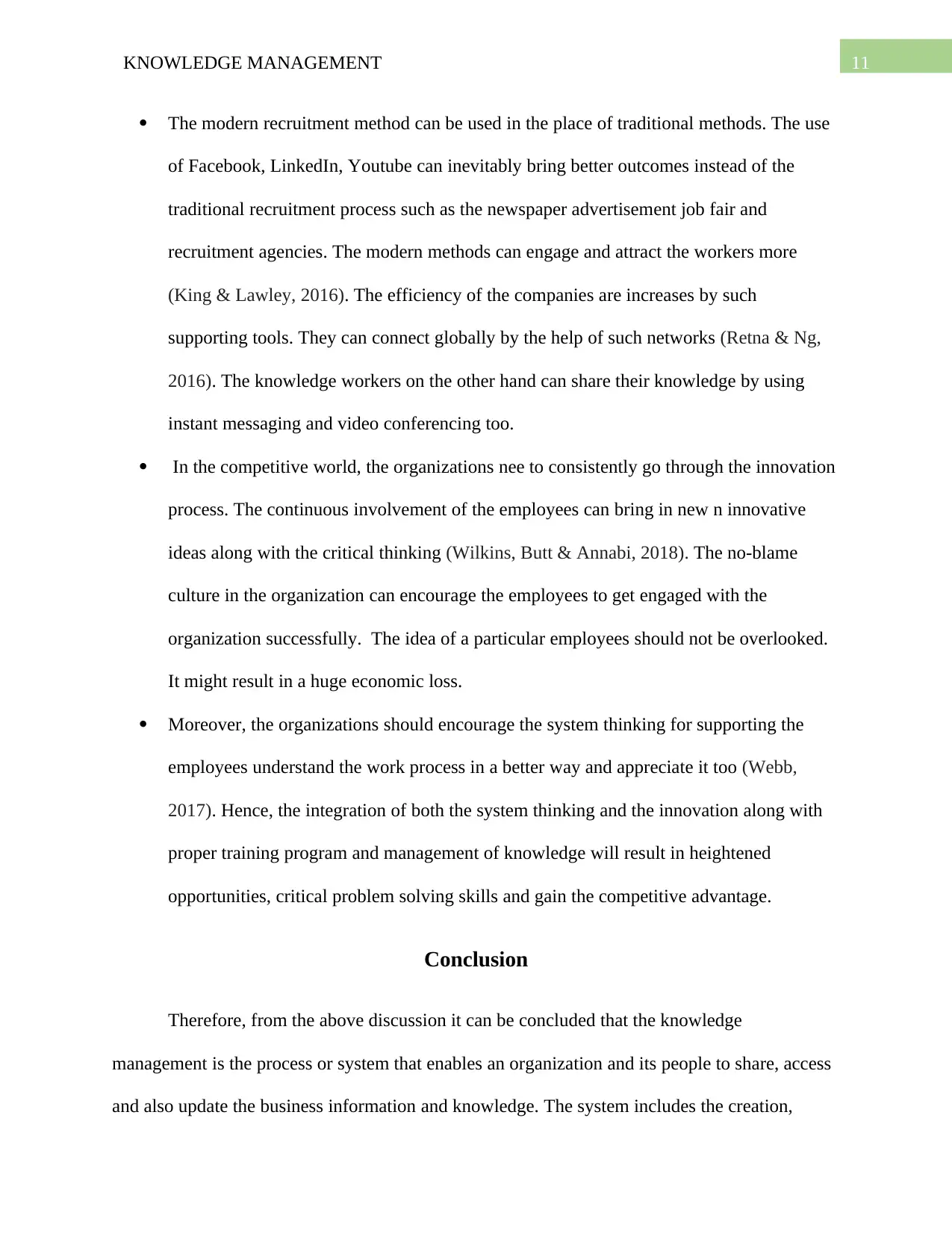
11KNOWLEDGE MANAGEMENT
The modern recruitment method can be used in the place of traditional methods. The use
of Facebook, LinkedIn, Youtube can inevitably bring better outcomes instead of the
traditional recruitment process such as the newspaper advertisement job fair and
recruitment agencies. The modern methods can engage and attract the workers more
(King & Lawley, 2016). The efficiency of the companies are increases by such
supporting tools. They can connect globally by the help of such networks (Retna & Ng,
2016). The knowledge workers on the other hand can share their knowledge by using
instant messaging and video conferencing too.
In the competitive world, the organizations nee to consistently go through the innovation
process. The continuous involvement of the employees can bring in new n innovative
ideas along with the critical thinking (Wilkins, Butt & Annabi, 2018). The no-blame
culture in the organization can encourage the employees to get engaged with the
organization successfully. The idea of a particular employees should not be overlooked.
It might result in a huge economic loss.
Moreover, the organizations should encourage the system thinking for supporting the
employees understand the work process in a better way and appreciate it too (Webb,
2017). Hence, the integration of both the system thinking and the innovation along with
proper training program and management of knowledge will result in heightened
opportunities, critical problem solving skills and gain the competitive advantage.
Conclusion
Therefore, from the above discussion it can be concluded that the knowledge
management is the process or system that enables an organization and its people to share, access
and also update the business information and knowledge. The system includes the creation,
The modern recruitment method can be used in the place of traditional methods. The use
of Facebook, LinkedIn, Youtube can inevitably bring better outcomes instead of the
traditional recruitment process such as the newspaper advertisement job fair and
recruitment agencies. The modern methods can engage and attract the workers more
(King & Lawley, 2016). The efficiency of the companies are increases by such
supporting tools. They can connect globally by the help of such networks (Retna & Ng,
2016). The knowledge workers on the other hand can share their knowledge by using
instant messaging and video conferencing too.
In the competitive world, the organizations nee to consistently go through the innovation
process. The continuous involvement of the employees can bring in new n innovative
ideas along with the critical thinking (Wilkins, Butt & Annabi, 2018). The no-blame
culture in the organization can encourage the employees to get engaged with the
organization successfully. The idea of a particular employees should not be overlooked.
It might result in a huge economic loss.
Moreover, the organizations should encourage the system thinking for supporting the
employees understand the work process in a better way and appreciate it too (Webb,
2017). Hence, the integration of both the system thinking and the innovation along with
proper training program and management of knowledge will result in heightened
opportunities, critical problem solving skills and gain the competitive advantage.
Conclusion
Therefore, from the above discussion it can be concluded that the knowledge
management is the process or system that enables an organization and its people to share, access
and also update the business information and knowledge. The system includes the creation,
⊘ This is a preview!⊘
Do you want full access?
Subscribe today to unlock all pages.

Trusted by 1+ million students worldwide
1 out of 16
Related Documents
Your All-in-One AI-Powered Toolkit for Academic Success.
+13062052269
info@desklib.com
Available 24*7 on WhatsApp / Email
![[object Object]](/_next/static/media/star-bottom.7253800d.svg)
Unlock your academic potential
Copyright © 2020–2025 A2Z Services. All Rights Reserved. Developed and managed by ZUCOL.





